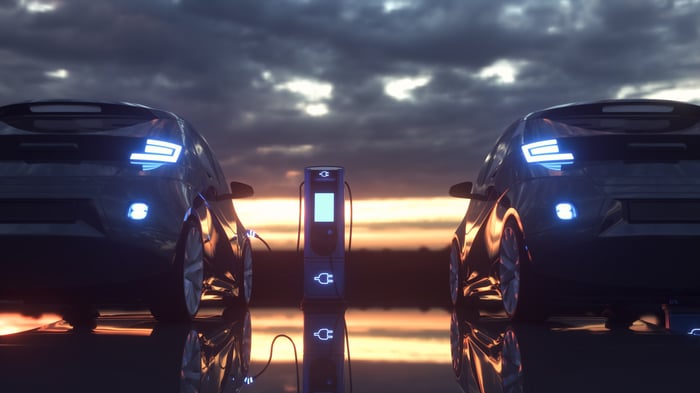It's been a difficult few years for the automotive industry. After declining growth in global light-vehicle sales in 2018 and 2019, hopes were high that 2020 would see the industry embark on a multiyear cyclical recovery.
But unfortunately, the pandemic had other ideas, and the lockdown measures caused a dramatic slump in sales in 2020. Here's a big-picture view of the key developments for investors in the industry.

Image source: Getty Images.
The global semiconductor shortage
As the economy recovered from the worst of the pandemic, investors started believing in a multi-year recovery in the market beginning in 2021. However, industry forecasters took down expectations for light-vehicle production in 2021 every quarter throughout the year. The reason was the global semiconductor shortage created by a combination of a lack of previous investment in automotive chip production, ongoing issues around production created by COVID-19, and an underlying increase in demand.
What's happening in 2022
Moving into 2022, the shortage and the demand for semiconductors spurred a massive boost in investment by automotive chip manufacturers, so investors can have confidence that more supply will come online in the coming years. Meanwhile, the dip in many raw material prices in the fourth quarter of 2021 created optimism that costs will ease while relaxing COVID-19 restrictions means production capacity can increase.
As such, investors in major car manufacturers like Ford (F 0.66%) and General Motors (GM -0.17%) and auto parts manufacturers like airbag and seat belt manufacturer Autoliv (ALV 0.41%) had reason to believe that (you guessed it) 2022 would mark the beginning of a multiyear recovery for the auto industry.
Unfortunately, almost precisely when that looked set to happen, the industrial world was plunged into dealing with the war in Ukraine.

Image source: Getty Images.
The downside risk
Aside from the reduction in demand from Russia and Ukraine, there are also significant issues on the supply side. For example, Ukraine is a leading supplier of neon gas used in semiconductor production and a major manufacturer of copper wiring harnesses used in vehicles. Russia and Ukraine are also major steel exporters. If that weren't enough, Russia produces 40% of the world's palladium, a metal used in catalytic converters and semiconductor production.
Although commodities/products (steel, palladium, copper, fertilizer, et cetera) are off their recent war-induced highs, it's not so simple to say everything is just fine.
The reality is that many auto-related companies based their full-year outlook on the assumption of a significant easing of issues in the second half, and they did not expect the price spikes in the first quarter.
The immediate impacts
As an immediate consequence, Ford and General Motors have both announced some production halts on the back of supply chain issues since the conflict started in Ukraine.
Moreover, leading industry forecaster S&P Global Mobility has cut its estimate for global light-vehicle production in 2022 by 2.6 million units to 81.6 million units and by 2.6 million in 2023 to 88.5 million units. The majority of the impact in 2022 will be felt in Europe with a 1.7 million cut expected, but North America is forecast to see a 480,000 drop in production expectations, too.
For Autoliv, it's not just a problem of a worsening outlook for car production; the company has sub-suppliers in Ukraine (wire harnesses, steering wheel components) and will also face margin pressure from higher-than-expected raw material prices.
Everything points to auto-related companies taking down their full-year guidance when they release first-quarter reports in the forthcoming earnings season.
Is it time to buy?
Investors' interest then turns to the perennial question of whether all the bad news is priced in or not? Unfortunately, that's a question that can't be answered until there's more clarity around the ending of the conflict. In addition, it's possible that the guidance cuts will be relatively large because there's a high level of uncertainty around the key issues.
It makes sense to reassess buying in after the next round of earnings reports, and after there's possibly a resolution to the horrific conflict across all of Ukraine. However, until then, earnings expectations in the auto industry will be under pressure.





